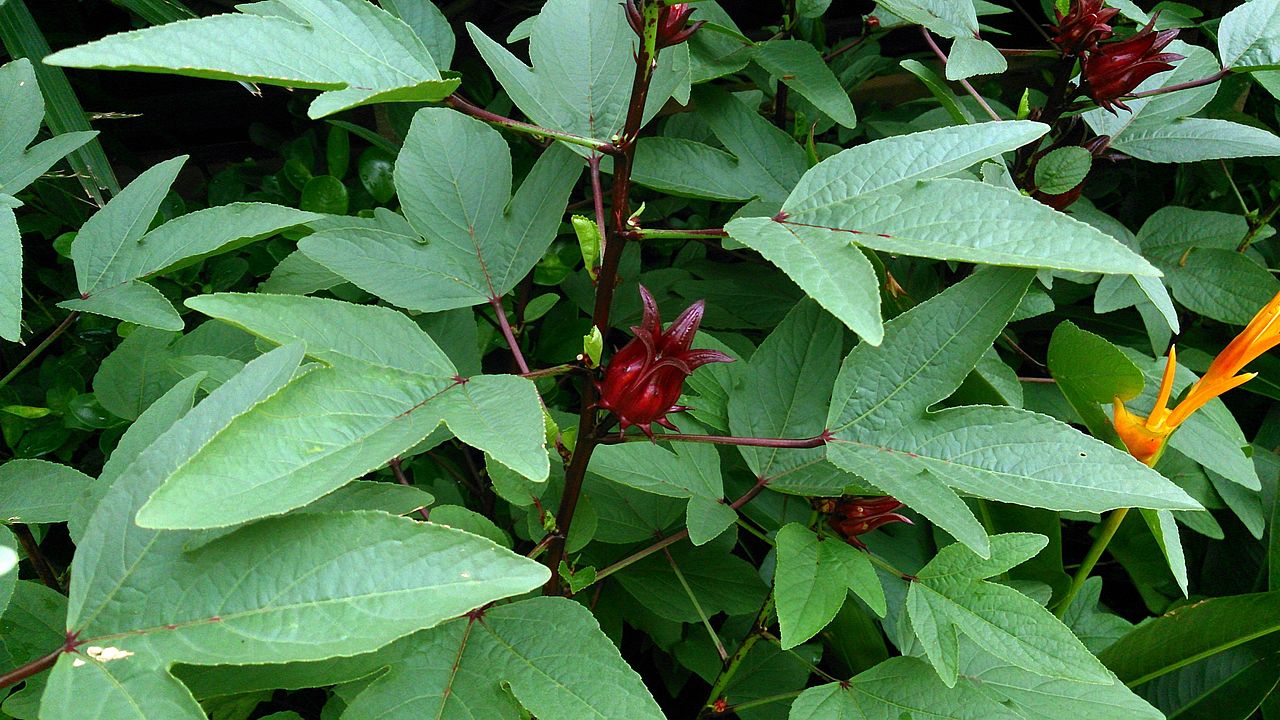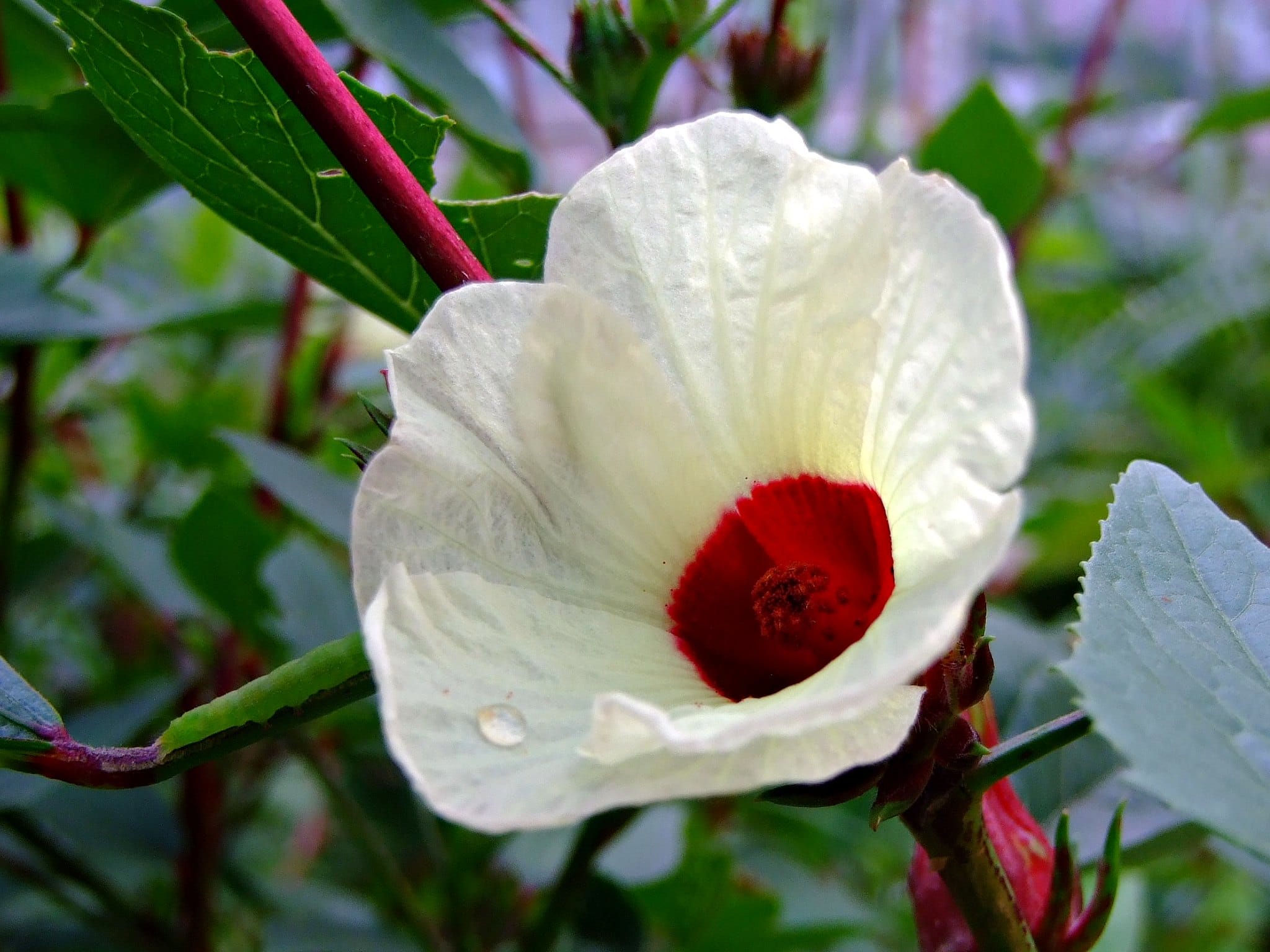
image - Flickr / Dinesh Valke
Herbaceous plants are a type of plants that can not be missing in a garden, since they are the ones that give it color and shape. There are many species, but this time I am going to tell you about Hibiscus sabdariffa, which is an annual mallow (lives one year) that can reach between 1 and 3 meters in height.
It is known as jamaica plant, although it is actually native to tropical Africa. Here's how to take care of it.
Origin and characteristics of the Jamaica plant

Image - Flickr / Kai Yan, Joseph Wong
Our protagonist is an annual plant originating from Egypt and Sudan to Senegal whose scientific name is Hibiscus sabdariffa. It is popularly known as Jamaica plant, Jamaica rose, Abyssinian rose, rosella, Guinean sour or saril. Grows to a maximum height of 3 meters, with tri or pentalobed leaves of about 15cm in length, alternate on the stem.
The flowers are 8-10cm in diameter, red at the base and pale at the ends., but what is most striking is the calyx, which is intense red, fleshy and rich in malic acid.
What is your care of the Hibiscus sabdariffa?

Image - Wikimedia / Mokkie
If you want to have a specimen of a Jamaican plant, we recommend that you provide it with the following care:
Location
It is a plant that grows well in semi-shade, although the ideal is that it gives direct sunlight. For this reason, you have to keep it outside, since inside the house it will not enjoy good health.
Earth
- Flower pot: not demanding. You can use a universal growing medium mix with 30% perlite. The important thing is that it has good drainage, since otherwise its roots would rot.
- Garden: the garden soil must be fertile, and have good drainage.
Irrigation
Frequent in summer, but moderate-scarce the rest of the year. Typically, it will be watered 3-4 times a week during the hottest, driest season, and somewhat less the rest of the year.
Use preferably rainwater or lime-free water, and water so that the soil or substrate is very moist. If you have it in a pot, in summer you can put a plate under it, especially if it is very dry and warm (30ºC or more), but in spring and autumn it is not recommended.
Subscriber
The rosella or Jamaican plant requires a regular supply of fertilizer throughout the season. Therefore, it is very interesting to pay it with ecological fertilizers, once a month. You can also use fertilizers for green plants, but only if you are going to have it solely as an ornamental plant.
Multiplication

Image - Flickr / Kai Yan, Joseph Wong
It multiplies by seeds in spring, following this step by step:
- First, you have to choose a seedbed. This may be a seedling tray (for sale here), pots with drainage holes, peat tablets (for sale No products found.), containers of yogurt or milk, ... Anything that is waterproof and that has or can be made some holes through which the water comes out, will do.
- Afterwards, the seedbed is filled with specific substrate (for sale here) and is watered consciously.
- Then, a maximum of 2-3 seeds are placed in each socket or pot, burying them a little, enough so that they are not exposed to the sun.
- Finally, the seedbed is placed outside, in semi-shade.
Keeping the substrate moist but not waterlogged, the seeds of the Hibiscus sabdariffa they will germinate in about 2 weeks.
Plagues and diseases
In general, it is quite resistant. But in hot climates and dry environments the mealybugs, red spiders or aphids they could harm it. To avoid this, there is nothing like having it well watered and fertilized 😉.
Anyway, if you have already seen a plague, do not hesitate to treat it with diatomaceous earth (for sale here) or with potassium soap (on sale here). Both are natural and ecological products, with great efficiency.
Pruning
Remove dried stems and wilting flowers. Thus, it will continue to look pretty for a while longer 🙂.
Rusticity
Does not resist the cold; in fact, after flowering and fruiting, the plant begins to dry out as it is an annual.
What uses is given to the Jamaica plant?
It has several:
Ornamental
It is a very decorative plant, ideal for growing in pots or gardens. Despite being tropical, it is a very interesting species also to have in warm temperate climates.
Culinary
The leaves are eaten as a vegetable, with the fresh calyces jams and ice creams are prepared, and with the fresh fruits drinks are prepared.
Medicinal - Properties and contraindications of the hibiscus flower

Image - Wikimedia / Popperipopp
The pink call of Jamaica has antiparasitic, diuretic, antihypertensive properties and can even be used as a mild laxative. It is taken as an infusion, which in Mexico is known as agua de Jamaica.
Therefore, it is a good ally for anyone who wants to lose weight or maintain their weight. It also reduces cholesterol, protects the liver, and strengthens the immune system.
However, pregnant women or those who want to be, should not consume it. The Jamaica plant can affect fertility and hormones, especially estrogen.
Where to buy?
You can buy seeds from here:
What did you think of this plant? Did you know her?

Hello, I would like to know the benefits of eating the leaves of the hibiscus flower plant and not only its flower, since I like them, they are acidic, and in the fish stew they are divine, who could tell me, someone who has knowledge of the plants.
Thank you very much for the information it was excellent to learn the benefits of the hibiscus plant
Thank you very much, José 🙂
I just bought a plant, it is a single branch, it measures about a meter, but it is November and although it is not very cold here in Guadalajara, I have doubts if I can plant it in the garden or leave it in a pot, on the stairs of the building. . Thanks a lot.
Hello Victor.
It is preferable to leave it in a pot until spring, so it will withstand winter better.
Greetings.
Excellent information, very clear and timely, thank you very much.
Hello, Enrique.
Thank you very much for your comment.
Greetings.
I love this plant I would like to have a couple at home
Hello Jorge.
We recommend looking for it in nurseries or garden stores in your area, or on the Internet.
A greeting.